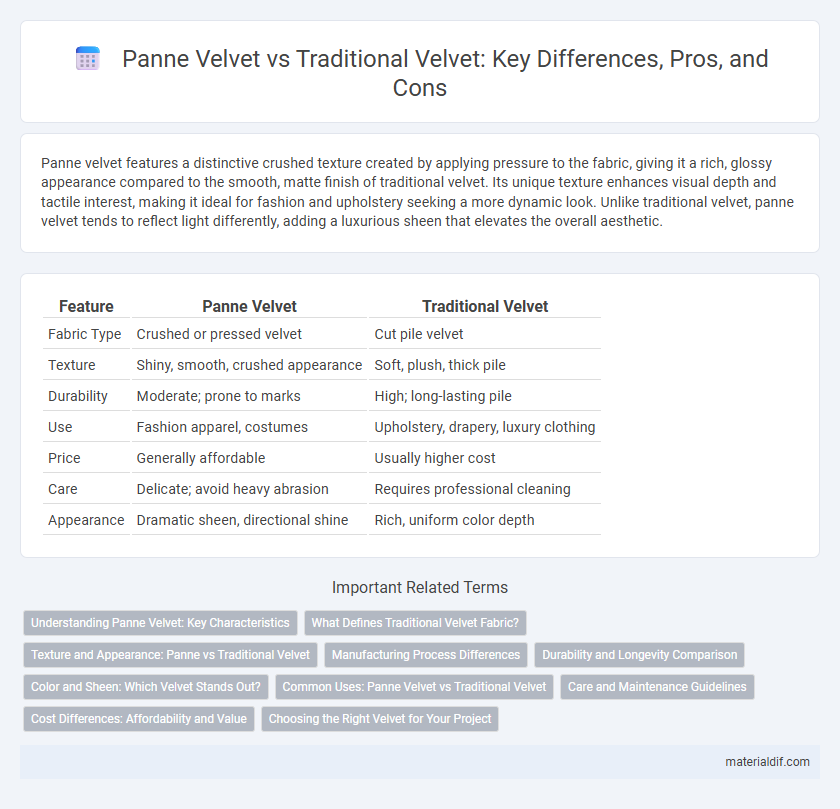Panne velvet features a distinctive crushed texture created by applying pressure to the fabric, giving it a rich, glossy appearance compared to the smooth, matte finish of traditional velvet. Its unique texture enhances visual depth and tactile interest, making it ideal for fashion and upholstery seeking a more dynamic look. Unlike traditional velvet, panne velvet tends to reflect light differently, adding a luxurious sheen that elevates the overall aesthetic.
Table of Comparison
| Feature | Panne Velvet | Traditional Velvet |
|---|---|---|
| Fabric Type | Crushed or pressed velvet | Cut pile velvet |
| Texture | Shiny, smooth, crushed appearance | Soft, plush, thick pile |
| Durability | Moderate; prone to marks | High; long-lasting pile |
| Use | Fashion apparel, costumes | Upholstery, drapery, luxury clothing |
| Price | Generally affordable | Usually higher cost |
| Care | Delicate; avoid heavy abrasion | Requires professional cleaning |
| Appearance | Dramatic sheen, directional shine | Rich, uniform color depth |
Understanding Panne Velvet: Key Characteristics
Panne velvet features a distinctive crushed texture achieved by pressure rolling during manufacturing, creating a shiny, plush surface that sets it apart from traditional velvet's smooth, even pile. This fabric's unique luster and stretchability make it ideal for luxurious apparel and upholstery requiring both softness and durability. While traditional velvet offers a classic matte or slight sheen finish, panne velvet's reflective highlights enhance visual depth and richness in design applications.
What Defines Traditional Velvet Fabric?
Traditional velvet fabric is defined by its dense pile weave, typically made from silk, cotton, or synthetic fibers, creating a soft, lustrous surface that reflects light. The pile is formed by weaving two layers of fabric simultaneously and then cutting them apart to produce a rich texture and depth. Unlike panne velvet, which is pressed to create a crushed, glossy finish, traditional velvet maintains a smooth, uniform pile that offers a classic, luxurious appearance.
Texture and Appearance: Panne vs Traditional Velvet
Panne velvet features a distinctive crushed texture achieved by applying pressure to the fabric, creating a glossy, reflective surface that contrasts with the smooth, matte finish of traditional velvet. This texture results in a dynamic appearance, with light and dark patches that shift depending on the angle, while traditional velvet offers a uniform, plush look with a soft, dense pile. The unique sheen and tactile variation of panne velvet make it ideal for statement pieces, whereas traditional velvet is favored for classic, understated elegance.
Manufacturing Process Differences
Panne velvet is produced using a mechanical pressure technique that presses the pile in one direction, creating a distinctive crushed texture and sheen. Traditional velvet is woven with upright loops of thread that are cut to form a smooth, dense pile, resulting in a soft and uniform surface. The manufacturing process of panne velvet involves additional steps like heat setting and pressing to maintain its lustrous, crushed appearance, differentiating it from the standard weaving method of traditional velvet.
Durability and Longevity Comparison
Panne velvet features a crushed, shiny texture achieved through pressure, which slightly compromises its durability compared to traditional velvet that has a denser, upright pile. Traditional velvet's longer, plush fibers provide greater resistance to wear and maintain their appearance over time, making it more suitable for high-traffic areas and furniture upholstery. While panne velvet offers a luxurious sheen, traditional velvet's superior fiber structure ensures enhanced longevity and resilience.
Color and Sheen: Which Velvet Stands Out?
Panne velvet features a distinctive directional pile that reflects light differently, creating a bold sheen and deeper, richer colors compared to traditional velvet's uniform, matte finish. The unique texture of panne velvet enhances color vibrancy and adds dimension, making it stand out in lighting conditions. Traditional velvet offers a softer, more muted color palette, while panne velvet is favored for its high-gloss look and dramatic visual impact.
Common Uses: Panne Velvet vs Traditional Velvet
Panne velvet is commonly used in fashion for garments like dresses, skirts, and evening wear due to its distinctive shiny, crushed texture and stretchability, offering a luxurious yet comfortable fit. Traditional velvet is favored in upholstery, drapery, and formal clothing because of its dense pile and rich, soft surface that provides durability and an elegant appearance. Both fabrics serve decorative and apparel purposes but differ in texture and flexibility, influencing their typical applications.
Care and Maintenance Guidelines
Panne velvet requires gentle care due to its crushed pile texture, best maintained by avoiding heavy pressure and using a soft brush to preserve its distinctive sheen. Traditional velvet, with its upright pile, benefits from regular vacuuming with a soft brush attachment to prevent matting and occasional steaming to remove wrinkles without damaging the fabric. Both types should be kept away from direct sunlight and moisture to maintain color vibrancy and fabric integrity over time.
Cost Differences: Affordability and Value
Panne velvet, produced through a pressure-twisting technique that creates a shiny, crushed appearance, is generally more affordable than traditional velvet due to its quicker manufacturing process and lower material costs. Traditional velvet, known for its dense, soft pile, often demands higher production expenses, resulting in a premium price point that reflects its luxurious texture and durability. Consumers seeking budget-friendly options find panne velvet offers significant value without sacrificing the characteristic elegance of velvet fabric.
Choosing the Right Velvet for Your Project
Panne velvet features a crushed, shiny texture achieved by applying pressure to the fabric in a single direction, offering a luxurious appearance with a smooth, glossy finish ideal for decorative projects and apparel that require a dramatic drape. Traditional velvet is characterized by its dense, evenly cut pile, providing a plush, soft feel with a matte or slightly lustrous surface suitable for upholstery, drapery, and garments needing rich texture and durability. Selecting between panne velvet and traditional velvet depends on the desired aesthetic, texture, and functional requirements, with panne velvet excelling in visual impact and sheen, while traditional velvet delivers classic elegance and resilience.
Panne Velvet vs Traditional Velvet Infographic

 materialdif.com
materialdif.com